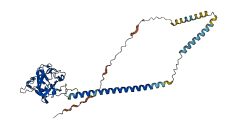Q9DA32
Gene name |
Sun5 (Spag4l) |
Protein name |
SUN domain-containing protein 5 |
Names |
Sperm-associated antigen 4-like protein |
Species |
Mus musculus (Mouse) |
KEGG Pathway |
mmu:76407 |
EC number |
|
Protein Class |
|

Descriptions
The autoinhibited protein was predicted that may have potential autoinhibitory elements via cis-regPred.
Autoinhibitory domains (AIDs)
Target domain |
|
Relief mechanism |
|
Assay |
cis-regPred |
Accessory elements
No accessory elements
Autoinhibited structure

Activated structure

1 structures for Q9DA32
| Entry ID | Method | Resolution | Chain | Position | Source |
|---|---|---|---|---|---|
| AF-Q9DA32-F1 | Predicted | AlphaFoldDB |
No variants for Q9DA32
| Variant ID(s) | Position | Change | Description | Diseaes Association | Provenance |
|---|---|---|---|---|---|
| No variants for Q9DA32 | |||||
No associated diseases with Q9DA32
6 regional properties for Q9DA32
| Type | Name | Position | InterPro Accession |
|---|---|---|---|
| repeat | Kinesin light chain repeat | 364 - 405 | IPR015792 |
| repeat | Tetratricopeptide repeat | 255 - 288 | IPR019734-1 |
| repeat | Tetratricopeptide repeat | 297 - 330 | IPR019734-2 |
| repeat | Tetratricopeptide repeat | 339 - 372 | IPR019734-3 |
| repeat | Tetratricopeptide repeat | 381 - 414 | IPR019734-4 |
| repeat | Tetratricopeptide repeat | 464 - 497 | IPR019734-5 |
Functions
6 GO annotations of cellular component
| Name | Definition |
|---|---|
| Golgi apparatus | A membrane-bound cytoplasmic organelle of the endomembrane system that further processes the core oligosaccharides (e.g. N-glycans) added to proteins in the endoplasmic reticulum and packages them into membrane-bound vesicles. The Golgi apparatus operates at the intersection of the secretory, lysosomal, and endocytic pathways. |
| integral component of nuclear inner membrane | The component of the nuclear inner membrane consisting of the gene products and protein complexes having at least some part of their peptide sequence embedded in the hydrophobic region of the membrane. |
| meiotic nuclear membrane microtubule tethering complex | A nuclear membrane protein complex which connects the nuclear outer and inner membranes together, and links links the nuclear lumen to cytoplasmic microtubules during meiosis. |
| nuclear envelope | The double lipid bilayer enclosing the nucleus and separating its contents from the rest of the cytoplasm; includes the intermembrane space, a gap of width 20-40 nm (also called the perinuclear space). |
| nuclear inner membrane | The inner, i.e. lumen-facing, lipid bilayer of the nuclear envelope. |
| sperm connecting piece | The segment of the sperm flagellum that attaches to the implantation fossa of the nucleus in the sperm head; from the remnant of the centriole at this point, the axoneme extends throughout the length of the flagellum. |
1 GO annotations of molecular function
| Name | Definition |
|---|---|
| protein-membrane adaptor activity | The binding activity of a molecule that brings together a protein or a protein complex with a membrane, or bringing together two membranes, either via membrane lipid binding or by interacting with a membrane protein, to establish or maintain the localization of the protein, protein complex or organelle. |
3 GO annotations of biological process
| Name | Definition |
|---|---|
| nuclear envelope organization | A process that is carried out at the cellular level which results in the assembly, arrangement of constituent parts, or disassembly of the nuclear envelope. |
| spermatid development | The process whose specific outcome is the progression of a spermatid over time, from its formation to the mature structure. |
| spermatogenesis | The developmental process by which male germ line stem cells self renew or give rise to successive cell types resulting in the development of a spermatozoa. |
6 homologous proteins in AiPD
| UniProt AC | Gene Name | Protein Name | Species | Evidence Code |
|---|---|---|---|---|
| P47069 | MPS3 | Spindle pole body assembly component MPS3 | Saccharomyces cerevisiae (strain ATCC 204508 / S288c) (Baker's yeast) | PR |
| O94901 | SUN1 | SUN domain-containing protein 1 | Homo sapiens (Human) | SS |
| Q9UH99 | SUN2 | SUN domain-containing protein 2 | Homo sapiens (Human) | SS |
| Q8TC36 | SUN5 | SUN domain-containing protein 5 | Homo sapiens (Human) | PR |
| Q8BJS4 | Sun2 | SUN domain-containing protein 2 | Mus musculus (Mouse) | EV |
| Q9D666 | Sun1 | SUN domain-containing protein 1 | Mus musculus (Mouse) | EV |
| 10 | 20 | 30 | 40 | 50 | 60 |
| MPRTRNIGAL | CTLPEDTTHS | GRPRRGVQRS | YISRMAEPAP | ANMNDPLLLP | LRMNTPGLSL |
| 70 | 80 | 90 | 100 | 110 | 120 |
| VQILLGYMSW | LTYLACFLRT | QTQQVFLNTC | RCKLFCQKVM | EKMGLLVLCV | FGFWMFSMHL |
| 130 | 140 | 150 | 160 | 170 | 180 |
| PSKVEVWQDD | SINGPLQSLR | MYQEKVRHHT | GEIQDLRGSM | NQLIAKLQKM | EAISDEQKMA |
| 190 | 200 | 210 | 220 | 230 | 240 |
| QKIMKMIQGD | YIEKPDFALK | SIGASIDFEH | TSATYNHDKA | RSYWNWIRLW | NYAQPPDVIL |
| 250 | 260 | 270 | 280 | 290 | 300 |
| EPNVTPGNCW | AFASDRGQVT | IRLAQKVYLS | NITLQHIPKT | ISLSGSPDTA | PKDIVIYGLE |
| 310 | 320 | 330 | 340 | 350 | 360 |
| SLPREEVFLG | AFQFQPENVI | QMFQLQNLPP | RSFAAVKVKI | SSNWGNPRFT | CMYRVRVHGS |
| 370 | |||||
| VTPPKDSHLE | PLS |